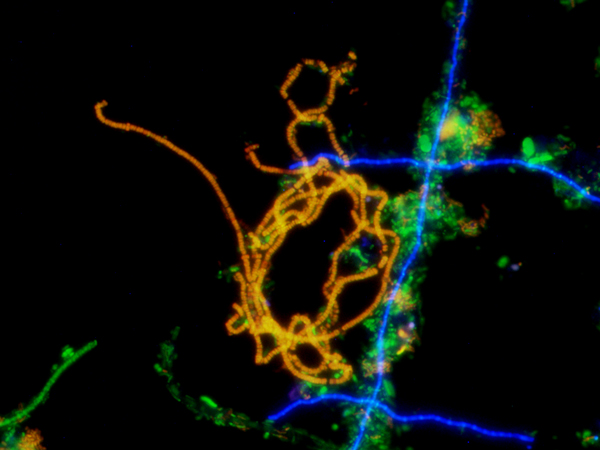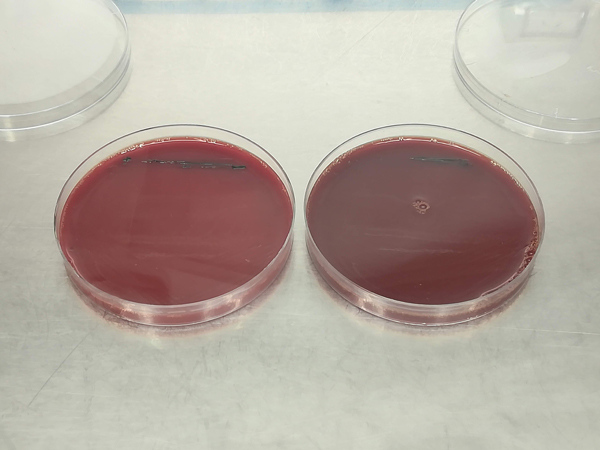1. Research Project 研究プロジェクト
Current major research projects are listed below.
現在の主な研究プロジェクトは以下のとおりです。
Wastewater Treatment 下水処理
Activated Sludge Bulking 活性汚泥バルキング


Aerobic biological treatment systems, mainly the conventional activated sludge system, are commonly used as the secondary treatment system in municipal wastewater treatment plants (WWTPs). The activated sludge system is a highly controllable system with a 100-year history. However, compromised liquid/solid phase separations in the secondary settling tank still give rise to serious operational problems. We are studying the filamentous bulking of activated sludge (hereafter bulking), which is one of the major causes of the solid-liquid separation problem.
Bulking is caused by the excessive growth of filamentous bacteria. A survey of filamentous bacteria conducted in the 1980s at domestic WWTPs in Japan reported that activated sludge contained a high percentage of type 021N filamentous bacteria. However, in our recent survey of domestic WWTPs in Japan, the percentage of type 021N was low, and other morphotypes of filamentous bacteria such as type 1851, Nostocoida limicola, type 0803, and type 1863 were observed as the dominant species (see photos). Considering that the dominant filamentous bacteria have changed due to changes in the composition of the influent sewage and updates to the treatment systems used at domestic WWTPs, it is necessary to reevaluate bulking countermeasures in response to changes in the dominant bacterial species.
Our group is currently analyzing filamentous bacteria that are dominant in bulking activated sludge at domestic WWTPs. We are also studying environmental factors that affect the growth of those filamentous bacteria. We hope to identify the filamentous bacteria species that cause bulking and develop the methods to specifically inhibit their growth to help eliminate bulking incidents and solid-liquid separation problems in domestic WWTPs.
下水処理施設では下水の二次処理方式として、標準活性汚泥法を中心とした好気性生物処理法が一般的に採用されています。活性汚泥法は100年の歴史のある制御性に優れたシステムです。しかし処理の最終工程(沈殿)で発生する活性汚泥と処理水との固液分離の障害は、未解決課題の一つとなっています。私たちはこの固液分離障害の一因である活性汚泥の糸状性バルキング(以下バルキング)について研究をしています。
バルキングは糸状性細菌の増殖により活性汚泥が膨化する現象です。その膨化によって活性汚泥の沈殿・濃縮性が悪化します。1980年代に国内の下水処理施設を対象に実施された糸状性細菌の調査では、下水処理施設の活性汚泥にはtype 021Nと呼ばれる形態の糸状性細菌の出現割合が高いことが報告されています。しかし近年私たちが実施した国内の下水処理施設の調査では、活性汚泥中に占めるtype 021Nの割合は低く、type 1851、Nostocoida limicola、type 0803、type 1863など別の形態の糸状性細菌が優占種として観察されました(写真)。流入下水の成分の変化や施設で採用される処理法の更新により、優占する糸状性細菌が変わってきたと考えると、バルキングの対策もその優占細菌種の変化に応じて検討しなおす必要があると言えます。
現在私たちのグループでは、活性汚泥のバルキングが顕著な施設を対象に、そこで優占する糸状性細菌の分析を行っています。またそれら糸状性細菌の増殖に影響を与える環境因子についても研究を進めています。バルキングの原因となる糸状性細菌種を把握し、その増殖を特異的に抑制する方法を確立して、下水処理活性汚泥のバルキングや固液分離障害の解消に役立てたいと考えています。
Periodontal Disease 歯周病

Periodontal disease is the most common bacterial infection in human history. It is caused by periodontopathogenic bacteria in dental plaque and, in severe cases, can lead to tooth loss and systemic disease. Treatment of periodontal disease requires removal of pathogenic bacteria from the oral cavity.
Current treatments include surgical procedures such as flap surgery and antibiotic therapy. However, a recent problem is the emergence of bacteria that do not respond to antimicrobial agents, called drug-resistant bacteria, and there are reports of cases in which symptoms do not improve even when patients are treated with antibiotics.
Phage therapy is considered as one of the new treatment options, which utilizes bacteriophages (hereafter referred to as phage). Phages are viruses that infect only bacteria and have high host specificity. Phages are classified into two categories: lytic phages and lysogenic phages. The former, phages with bacteriolytic properties, can kill bacteria. Therefore, identification and appropriate administration of bacteriolysis phages that specifically infect periodontopathogenic bacteria can be expected to reduce only the target bacteria without disturbing the indigenous flora in the oral cavity.
Our group is currently searching for phage in several periodontopathogenic bacteria. We are also studying the role of phage in the oral cavity. Through this research, we hope to utilize phage therapy in the treatment and prevention of periodontal disease in the future.
歯周病は人類史上最も感染者数の多い細菌感染症であるとされています。発症の原因はデンタルプラーク内の歯周病原性細菌であり、症状が進行し重度となると歯が抜け落ちてしまうことや全身疾患を誘発することもあります。歯周病の治療では口腔内から病原性細菌を除去することが必要です。
現行の治療法として、フラップ手術などの外科治療や抗生物質による治療が用いられています。しかし近年問題となっているのが、薬剤耐性菌と呼ばれる抗菌薬の作用しない細菌の出現であり、抗生物質を患者に投与しても症状が改善しない事例が報告されています。
歯周病の新たな治療法の一つとして考えられているのが、バクテリオファージ(以下ファージ)を利用したファージセラピーです。ファージは細菌にのみ感染し、高い宿主特異性を持つウイルスです。ファージは溶菌性ファージと溶原性ファージの2つに分類されます。前者の溶菌の特性を持つファージは細菌を死滅させることができます。したがって歯周病原性細菌に特異的に感染する溶菌性ファージを同定し、適切に投与することで、口腔内の常在細菌叢を乱すことなく標的細菌のみを減らす効果が期待できます。
現在我々のグループはいくつかの歯周病原性細菌を対象にファージの探索を行なっています。また口腔内におけるファージの役割についても研究を進めております。本研究を通して将来的にファージセラピーを歯周病の治療、及び予防として役立てたいと考えております。
Decarbonization 脱炭素

We are focusing on biomethanation to realize a decarbonized society. Biomethanation is a reaction that synthesizes methane (the main component of natural gas) from hydrogen and carbon dioxide by microorganisms called hydrogenotrophic methanogens. By using "green hydrogen", obtained by electrolyzing water using renewable electricity, and carbon dioxide recovered from combustion exhaust gases, it is possible to convert renewable electricity via hydrogen into an energy source equivalent to natural gas, while also making it possible to utilize carbon dioxide.
In biomethanation, it is necessary to supply dissolved and highly pure hydrogen and carbon dioxide to microorganisms. However, due to the low solubility in water, finding an efficient way to supply hydrogen remains a challenge. Moreover, there are still issues to be addressed in terms of energy input and costs for separating and refining high-purity carbon dioxide from combustion exhaust gases and other sources. To solve these problems simultaneously, we proposed a new biomethanation technology that utilizes a gas-permeable membrane.
As shown in the figure, carbon dioxide is separated and purified by water scrubbing (dissolving in water), taking advantage of the fact that the solubility of other components (mainly nitrogen and oxygen) contained in combustion exhaust gases is significantly lower than that of carbon dioxide. After scrubbing, the dissolved carbon dioxide is biologically converted into methane, which is less soluble in water, in a biomethanation tank and then recovered as a gas. In other words, biomethanation also serves as a recovery (stripping) process by insolubilizing dissolved carbon dioxide. The biomethanation tank uses "membrane biofilm reactor (MBfR)," which uses a biological film on the surface of a gas-permeable membrane. When hydrogen gas is supplied from the inside of a hollow fiber gas-permeable membrane, it permeates in a dissolved state to the bulk (aqueous phase) side. on which a biofilm consisting mainly of hydrogenotrophic methanogens fixes, and a biomethanation reaction takes place using the supplied dissolved hydrogen and the dissolved carbon dioxide recovered in the scrubbing tank. By completing the supply and consumption of hydrogen in the same place (the surface of gas-permeable membrane), it is possible to prevent from hydrogen remaining in the produced methane.
This novel technology was proposed in 2023 and is currently undergoing laboratory-scale verification. We are actively conducting R&D by combining our group's expertise in membrane and complex microbial system analysis technology with the knowledge of our research partners (Sanki Engineering and Nishimatsu Construction).
脱炭素社会の実現に資する技術の一つとして、バイオメタネーションに着目しています。バイオメタネーションは、水素資化性メタン生成古細菌と呼ばれる微生物のはたらきで、水素と二酸化炭素からメタン(天然ガスの主成分)を合成する反応です。原料として、再生可能電力で水を電気分解して得たいわゆるグリーン水素と、燃焼排ガスなどに含まれている二酸化炭素とを用いれば、再生可能電力を水素経由で天然ガス相当のエネルギー源に変換できるとともに、二酸化炭素の利活用が可能となります。
バイオメタネーションでは、微生物に溶存態かつ高純度の原料ガスを供給する必要があります。しかしながら、水素は水への溶解性が低いため、効率的な供給方法が課題となっています。また、燃焼排ガスなどから高純度の二酸化炭素を分離・精製する手法についても、投入エネルギーや費用の面で課題が残されています。これらの課題を同時に解決するため、気体透過膜を活用した新たなバイオメタネーション技術を考案しました。
図に示すとおり、二酸化炭素の分離・精製は、水洗(水への溶解)で行います。これは、燃焼排ガスなどに含まれる他成分(主に窒素・酸素)の溶解性が、二酸化炭素に比べて十分に低い性質を利用しています。水洗の後、バイオメタネーション槽で溶存二酸化炭素を水に溶けにくいメタンに変換して、気体として回収します。つまり、バイオメタネーションが、溶存二酸化炭素の不溶化による回収工程の役割も兼ねています。さらに、バイオメタネーション槽には、気体透過膜表面の生物膜による処理技術「membrane biofilm reactor (MBfR)」を適用しています。中空糸状の気体透過膜の内側から水素ガスを供給すると、バルク(水相)側に溶存態で透過します。気体透過膜の表面には水素資化性メタン生成古細菌を中心とする生物膜が付着して、供給された溶存水素と、水洗槽で回収した溶存二酸化炭素とを原料に、バイオメタネーション反応を行います。水素の供給と消費を同じ場所(気体透過膜表面=生物膜)で完結させることで、生成したメタンへの水素の残存を防ぎます。
この新技術は、2023年度後半に考案して、まだ実験室規模の検証を行っている段階です。我々のグループの得意とする膜や複合微生物系の解析技術と、共同研究先の民間企業(三機工業株式会社・西松建設株式会社)の知見とを合わせて、精力的な研究開発を進めています。
2. Analytical instruments 分析機器
The main equipment owned by the laboratory is listed below.
研究室で所有する主な機器を以下に示します。
Genetic analysis 遺伝子解析
- Epifluorescence microscope (Olympus BX-51)
落射蛍光顕微鏡 (Olympus BX-51) - Inverted microscope (Olympus IX-71)
倒立顕微鏡 (Olympus IX-71) - Quantitative PCR system (Takara Bio TP800)
定量PCR装置 (Takara Bio TP800) - Electroporation System (Bio-Rad Gene Pulser Xcell Electroporation Systems)
エレクトロポレーションシステム (Bio-Rad Gene Pulser Xcell Electroporation Systems) - Ultra-micro UV-visible spectrophotometer (Thermo Scientific NanoDrop One)
超微量紫外可視分光光度計 (Thermo Scientific NanoDrop One) - Sequencer (Nanopore MinION)
シークエンサー (Nanopore MinION)
Microbial culture 微生物培養
- Biohazard safety cabinet (HITACHI SCV-1009ECIIA2, ESCO AC2-4N7)
バイオハザード対策用キャビネット (HITACHI SCV-1009ECIIA2, ESCO AC2-4N7) - Bio clean bench (ESCO BCB-4E7)
バイオクリーンベンチ (ESCO BCB-4E7) - Low temperature incubator (PHC MIR-154S-PJ)
低温インキュベータ (PHC MIR-154S-PJ) - Multi-gas incubator (PHC MCO-170MUVH-PJ)
マルチガスインキュベータ (PHC MCO-170MUVH-PJ) - Anaerobic chambers (Sheldon Manufacturing BACTRON 300)
嫌気性チャンバー (Sheldon Manufacturing BACTRON 300)
Others その他
- Autoclave (TOMY LSX-300)
オートクレーブ (TOMY LSX-300) - Ultrapure water equipment (Merck Direct-Q UV 3)
超純水製造装置 (Merck Direct-Q UV 3) - Total organic carbon analyzer (Shimadzu TOC-L)
全有機炭素計 (Shimadzu TOC-L) - Cooling centrifuge (Kubota 3520)
冷却遠心機 (Kubota 3520, Thermo Scientific Sorvall ST 8R) - Ultra low freezer (PHC MDF-C8V1-PJ)
超低温フリーザー (PHC MDF-C8V1-PJ) - Hydrogen gas generator (Scitem YH-500)
水素ガス発生装置 (Scitem YH-500)
3. Achievements 研究業績
Please refer to the following databases for research achievements.
研究業績については以下のデータベースをご参照ください。

 ynu.ac.jp
ynu.ac.jp